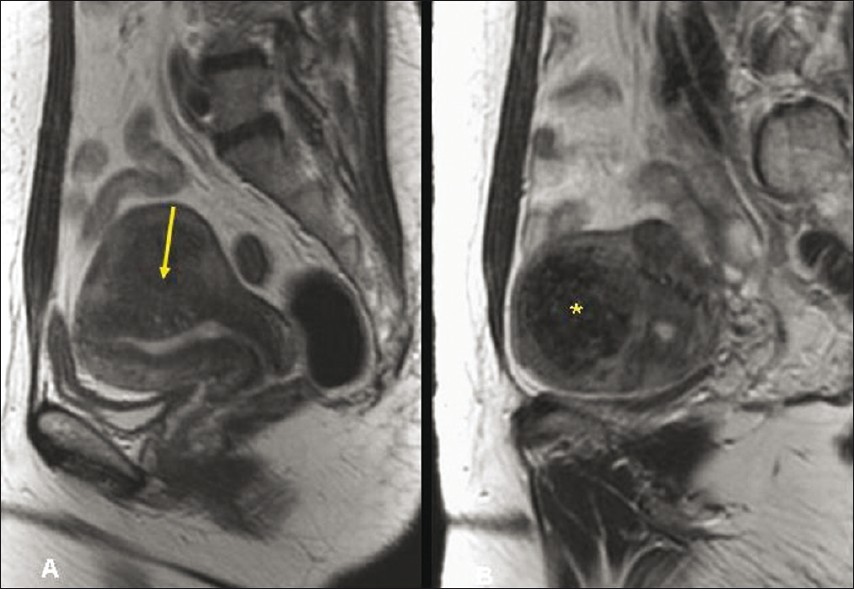Focal uterine adenomyosis is a localized disease, the focus of which is in the overgrown endometrium. As a rule, the lesion site has clear contours. The focal form of the disease is one of the varieties of endometriosis, which distinguishes the disease exclusively from uterine spread. Depending on the stage of the lesion and the thickness of the germination of the myometrium, experts identify three main degrees of severity of the disease:
- easy;
- average;
- heavy.
Features of the disease
To understand what it is - focal adenomyosis, let's talk about the features of pathology. The endometrial layer is located throughout the uterus. It is regularly updated through the menstrual cycle. This helps to prepare the woman's body for possible fertilization and gestation of the embryo. Focal uterine adenomyosis occurs, as a rule, in older women who are already 40 years old and the first symptoms of menopause have arisen.

In such women, regular changes in the level of estrogen in the body can be noted. At the same time, they have hot flashes, sweating is much stronger, and also dizzy. If such jumps last too long, then against their background a woman begins to develop adenomyosis of the focal form of the lesion.
This pathology is a type of internal endometriosis, which can be diffuse and affect the entire uterine cavity. Focal adenomyosis is characterized by a specific location of the endometrium in various parts of the uterus.
The main problems in the diagnosis and treatment of the disease are to identify the stage of the lesion. There are several forms of such a disease, two of which are susceptible to medical treatment, and the rest are eliminated only through surgery.
Disease development process
Features of the formation of the lesion site in the focal form of adenomyosis look like this:
- formed lesions do not form a capsule;
- they are distinguished by their infiltrative growth and can easily transfer to nearby tissues;
- endometrioid cells lead to the beginning of the destruction of the affected tissue;
- they, just like malignant cells, rapidly spread throughout the body through blood flow and lymph.
Gynecologists report that the internal form of uterine endometriosis is a rather dangerous disease, which is very important to treat in a timely manner, since otherwise it can lead to serious complications.

In the absence of proper treatment, the patient may experience infertility. In addition, the symptoms of endometriosis most often represent a strong pain syndrome, which can adversely affect the general condition of a woman, worsen her well-being and activity.
The main forms of the disease
Specialists distinguish three forms of the described disease:
- Diffuse-focal uterine adenomyosis - endometrioid cells are localized mainly on the inner surface of the uterus.
- Nodular adenomyosis - cells form nodes that contain blood or exudate. This is due to the fact that the cells in the nodes continue to perform their functions, focusing on the woman’s menstrual cycle. With such a disease, single or multiple nodes can form in the uterine cavity.
- Focal adenomyosis. The growth of the endometrium with this form of the disease occurs in certain areas of the uterus, in the walls of the organ - extensive foci. The size of the lesions in this case can be very different. Focal uterine adenomyosis progresses, like other diseases, passing in several stages. The disease is treated with the same methods.
Risk factors
The most common risk factors for adenomyosis are:
- problems with the endocrine system;
- woman's age;
- heredity;
- socio-economic situation.
Uncommon factors:
- late onset of menstruation;
- late birth or childbirth with complications;
- regular abortions;
- strong radiation and thermal procedures aimed at the pelvic area.

Unfortunately, conservative or combined treatment in rare cases leads to a woman's full recovery. Later stages of the disease are a common cause of infertility. But timely treatment helps to achieve a more or less long-term remission, get pregnant and give birth to a child. True, in this case, it is important to remember that there is a high risk of spontaneous abortion or the onset of premature birth.
Main stages
Specialists divide focal adenomyosis of the uterine body into the following stages:
- At this stage of development, the depth of proliferation of the foci of the endometrium into the muscle layers of the uterus reaches 1/3 of the part. With the timely detection of a dangerous formation in the cavity of the named organ, it can be easily and quickly treated without complications.
- The endometrium in the uterus extends to 1/2 part, so the gynecologist prescribes the patient a course of hormonal medications, as well as the passage of appropriate physiotherapeutic procedures.
- In this case, the endometrium is widely distributed in several parts of the uterus, localized in the outer walls of its muscle layer, leading to the appearance of more serious complications and problems in the patient's body.
- What is diffuse focal adenomyosis 4 tbsp.? In this case, the endometrium begins to actively affect tissues located outside the uterine cavity. Neoplasms begin to form on neighboring organs. As a rule, the doctor prescribes the patient a mandatory surgical intervention.
The main reasons for the appearance
Researchers have not yet fully studied the diffuse-focal form of adenomyosis and have not identified all the causes that provoke its appearance. At the same time, doctors note that such a lesion is most often detected in patients, in the hormonal background of which serious and prolonged failures occur. Such women are in a special risk zone, therefore, they must necessarily carefully monitor their health and, when the first signs of damage appear, immediately seek help from a specialist.
The main factors that lead to the appearance of focal uterine adenomyosis include: frequent pregnancies, some surgical interventions, installation of a spiral, frequent curettage or abortion.

In addition, the following factors can be attributed to provocations:
- Exposure to the disease at the genetic level. Moreover, a woman may experience not only focal adenomyosis, but also other forms of endometriosis.
- Problems with the amount of hormones in the body: too much estrogen or lack of progesterone.
- Regular stresses, experiences, emotional outbursts, abnormal rhythm of life, excessive stresses of both mental and physical nature.
- Strengthened sports.
- The presence of bad habits, as well as uncontrolled intake of drugs that have not been prescribed by the attending specialist, and not following the dosage.
Theories of Appearance
Doctors, in explaining the causes of the appearance and development of internal uterine endometriosis, rely on the following theories:
- Very rarely, a disease of this form is detected in young girls (before puberty). It is believed that under the influence of intrauterine disorders, foci of endometriosis actively move to adjacent tissues, which begin to progress immediately after puberty.
- During menstruation, a certain amount of blood, in which the endometrial cells are located, is thrown into the peritoneal cavity. This process is also called retrograde menstruation. But far from all women, endometrioid components can normally take root in the peritoneum. To do this, these elements need to provide certain conditions, which will be in violation of the hormonal and immune systems.
- Many diseases associated with the reproductive system have to be treated through surgery. Adenomyosis often appears after surgery, which provokes the destruction of the inner layer of the uterus. As a result of such exposure, endometrioid cells receive all the necessary conditions for penetration into the myometrium and deeper layers of the organ.
Internal endometriosis can also occur as a result of exposure to negative factors from the side. A woman should always remember that if you do not start timely treatment of the inflammatory process in the uterus and other genital organs, then as a result this can affect not only reproductive function, but also lead to more serious complications. Infections, regular stress and anxiety can increase the risk of the appearance and progression of uterine adenomyosis by reducing the protection of cellular immunity.
Main symptoms
The main symptom of adenomyosis in the uterine organ is severe pain in the pelvis, as well as the onset of heavy bleeding. During the development of the disease, a woman feels tired and unwell. By the way, most often its first two stages are asymptomatic, so it is very important to visit a doctor regularly to diagnose a health condition.
The main symptoms of the pathology directly depend on the monthly. Experts have found that the foci of the disease menstruate at the same time with a correctly located endometrium. The inability to remove endometrial cells from the focus leads to the onset of the inflammatory process.

Doctors distinguish the following signs of focal adenomyosis:
- Pain It was found that pain in the focal form of the lesion is distinguished by its cyclical nature. Most often, he becomes stronger before and during critical days. The pains are localized predominantly in the lower abdomen, and in the sacrum, irradiation to the lower extremities may occur. In some cases, the pain is so acute that a woman has to call an ambulance and undergo research in the gynecological department.
- Strong bleeding during menstruation. Most often, the patient notes a large number of blood discharge. However, they can be observed as smearing before and after menstruation. In some cases, strong periods indicate the presence of uterine fibroids, which often occurs with adenomyosis. Internal endometriosis and uterine fibroids result from problems with the hormonal system.
- Heavy bleeding in the absence of menstruation. A symptom such as severe bleeding can indicate an active process of the development of the disease. At the same time, they provoke the development of anemia and severe blood loss.
- Infertility or miscarriage. Due to problems with the production of hormones with internal endometriosis, anovulation often occurs. Degenerative processes prevent the fertilized egg from reaching the organ normally and gain a foothold in its cavity. With adenomyosis in the woman’s body, inflammation of the uterus can begin, which will violate the natural contractile abilities of this organ and lead to miscarriage at an early stage of embryo development.
The main symptoms of adenomyosis can be detected during a gynecological examination in a clinic. In this case, the specialist will identify the pain of the uterus and the growth rate of the lesion. Also, the doctor will determine the various changes regarding the shape and consistency of the uterine body. Most often, during internal endometriosis, the organ takes a spherical shape, and its density increases.
Diagnostic measures of the lesion
To determine diffuse focal adenomyosis of 13 and 15 mm, it is necessary to undergo an ultrasound scan, which will help determine the specific signs of the disease. A transvaginal scan will help identify an accurate diagnosis of the disease. If you do not start timely treatment of focal uterine adenomytosis, then as a result, as already mentioned, the patient may experience infertility or she will have to partially or even completely remove the said organ.

Most often, the diagnosis of such a disease is carried out using ultrasound. To identify focal adenomyosis and possible uterine cancer, a biopsy and analysis on CA-125 are performed. All this allows a good look at the signs of pathology of both the organ itself and neighboring tissues. It is best to conduct such an examination before menstruation. The doctor will be able to accurately identify the nature of the disease, its shape, the size of the uterine body, the thickness of the walls and structures of the myometrium. In order to take a biopsy, the doctor prescribes a hysteroscopy.
The main methods of treating lesions
It is important to remember that only the first two stages of adenomyosis respond to treatment. But for those who fell ill with such a defeat, unfortunately, a complete recovery, as a rule, does not occur. This can be explained by the fact that the focal form of adenomyosis in the uterine cavity often appears repeatedly, for this reason it is important for the patient to carefully monitor the hormonal system.
All types of adenomyosis are treated with two common methods. In the first case, the specialist prescribes the use of anti-adenomyosis drugs. If such therapy does not improve a person’s condition, then specialists prescribe surgery. All methods for removing endometriosis of the internal form will differ from each other depending on the severity and germination of the lesion, as well as the state of the woman's reproductive system.
The most common method for removing the lesion is uterine artery embolization. Other procedures to remove the affected area, including curettage, are quite dangerous and can lead to infertility.
To begin the proper treatment of uterine disease, the specialist will rely on the following factors:
- woman's age;
- the presence or absence of children, the desire to give birth in the future;
- lack of childbirth;
- stage of development of the lesion;
- the main symptoms of the lesion and their manifestation.
If a woman has any problems with the functioning of the kidneys, liver, blood vessels or diabetes is present, then he prescribes a course of taking hormonal drugs. Whether to remove the uterine adenomyosis, the attending physician will decide after a diagnostic examination. He will study the history of a woman, identify the presence of asthma or obesity. And the goal of treating the disease will be the introduction of a woman into a medical menopause.
Internal endometriosis must be treated with hormonal drugs, but it is important to remember that they often provoke adverse reactions. When carrying out treatment, a woman should follow a special diet, exclude all harmful products from her diet. Add as many foods enriched with proteins and vitamins to the menu as possible. Additionally, the doctor prescribes immunotherapy and physiotherapy. With a focal form of uterine adenomyosis, a woman often develops neurotic diseases against the background, in which the help of a psychotherapist is very important.
Drug treatment
Drug treatment can be carried out together with non-traditional. This may include hirudotherapy, or treatment with leeches, homeopathy and medication. This set of procedures always brings a positive effect.

But doctors forbid patients to self-medicate and purchase drugs without a prescription, as this is extremely dangerous for the health and condition of the woman herself. At the same time, with the right choice, homeopathic medicines will help strengthen the effect of taking other medicines.
Many women have tried leech therapy. It helps to disperse the bloodstream and eliminate the process of inflammation inside the body.
Modern treatments
In medicine, new methods have been developed for the treatment of focal uterine adenomyosis:
- Electrocoagulation In this case, an electric discharge acts on pathological formations in the body, which destroys focal formations in a mild form.
- Embolization. This method of treatment is based on the closure of blood flow, which flows to all formations. Due to the lack of oxygen, the formations begin to collapse rapidly.
- Ablation helps destroy the lining of the uterus.
All the described treatment methods have their own advantages, with the help of them many patients were able to eliminate adenomyosis without dangerous health consequences.
In addition, doctors advise to lead an active lifestyle, maintain proper nutrition, exercise regularly and lead a proper sex life. With regular problems in the menstrual cycle, it is important to immediately go to the doctor and conduct a comprehensive examination for the timely diagnosis of pathology.